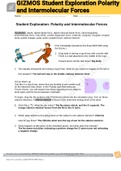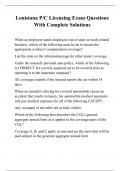Exam (elaborations)
GIZMOS Student Exploration Polarity and Intermolecular Forces
- Institution
- Harvard University
Exam (elaborations) GIZMOS Student Exploration Polarity and Intermolecular Forces Student Exploration: Polarity and Intermolecular Forces Vocabulary: dipole, dipole-dipole force, dipole-induced dipole force, electronegativity, intermolecular force, ionic bond, London dispersion force, molecule,...
[Show more]




